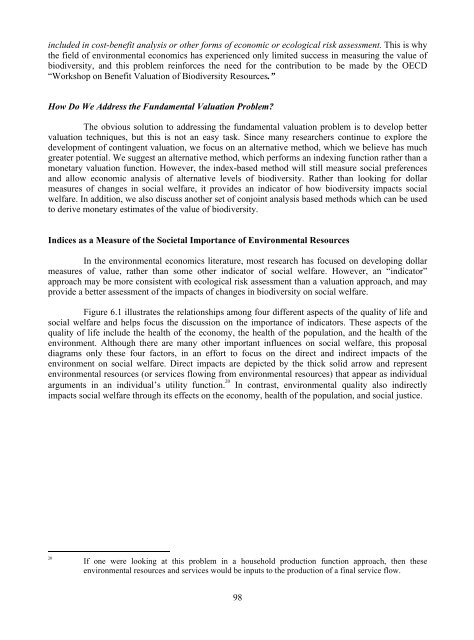- A group <strong>of</strong> non-pr<strong>of</strong>it organisations is collecting money to purchase the land, whichtotals 4 600 acres. The land would then be donated to public agencies to administer aspreserved land. Three hundred acres would actually be incorporated into the NationalPark, with the remainder administered by the Tennessee Wildlife Resources Agency forpublic outdoor recreation.- Would you be willing to donate US$ X to aid in the purchase <strong>of</strong> the land?In theory, contingent valuation can measure both direct use values and indirect use values.However, the method is quite controversial because <strong>of</strong> its hypothetical nature, and a series <strong>of</strong> potentialbiases have been identified. The hypothetical nature <strong>of</strong> the technique leads to two problems. First, thesurvey respondents have no experience in making decisions like this in the real world. In the realworld, people seldom, if ever, confront the problem <strong>of</strong> deciding how much to pay to improveenvironmental quality, especially those environmental resources, which provide indirect use values, orecological services, or both. This lack <strong>of</strong> experience can lead to either over or under statements <strong>of</strong> truewillingness to pay. Another problem created by the hypothetical nature <strong>of</strong> the decision framework isthat people do not actually make real economic commitments. This has been hypothesised to lead to asystematic overstatement <strong>of</strong> true willingness to pay, although the empirical evidence on the existence<strong>of</strong> this bias is mixed. 18In addition to these problems generated with the hypothetical nature <strong>of</strong> contingent valuation,there are two other important biases, which have been identified. These are part/whole biases andembedding biases. Part/whole biases are used to describe the empirical observation that thewillingness to pay for a smaller environmental resource is <strong>of</strong>ten measured to be essentially equal tomeasures <strong>of</strong> the willingness to pay for a more encompassing environmental resource. Economic theorysuggests that the willingness to pay for the more encompassing good should be at least as large as thewillingness to pay for the good which is encompassed. For example, the willingness to pay for airquality improvements in a system <strong>of</strong> parks should be larger than the willingness to pay for air qualityimprovements in one park in the system. However, empirical studies have shown there to be littledifference between the two in a variety <strong>of</strong> applications. Embedding biases occur when the surveyrespondent includes in his statement <strong>of</strong> willingness to pay the value <strong>of</strong> goods other than those, whichare the subject <strong>of</strong> the survey. For example, if a survey is about the willingness to pay for improvedvisibility associated with air quality improvements, the respondent may include his or her willingnessto pay to avoid air pollution impacts to ecosystems or human health.In summary, contingent valuation is quite controversial and many researchers believe it to besubject to systematic biases, especially when applied to the valuation <strong>of</strong> indirect use values.Contingent valuation models have had a mixed performance when subjected to internal and externalvalidity tests. 19 This leads to what can be referred to as the fundamental valuation problem. Revealedpreference models tend to pass external and internal validity tests, but by their very nature can not beused to measure indirect use values. Contingent valuation models can be used to measure indirectvalues, but there are problems with implementation and the techniques are controversial andcontentious because <strong>of</strong> the potential biases associated with contingent valuation and the lack <strong>of</strong>internal and external validity. In addition, neither revealed preference models nor contingent valuationmodels have been successfully applied to measure the value <strong>of</strong> the full range <strong>of</strong> ecological services. Asa result <strong>of</strong> these shortcomings, indirect-use values and the value <strong>of</strong> ecological services seldom are1819See Neill et al. (1994), Kealy et al. (1990), Duffield and Patterson, Siep and Strand (1992), Cummingsand Harrison (1992).See Bjornstad and Kahn (1996), Portney (1994), Diamond and Hauseman (1994), and Hanneman(1994).97
included in cost-benefit analysis or other forms <strong>of</strong> economic or ecological risk assessment. This is whythe field <strong>of</strong> environmental economics has experienced only limited success in measuring the value <strong>of</strong>biodiversity, and this problem reinforces the need for the contribution to be made by the <strong>OECD</strong>“Workshop on Benefit <strong>Valuation</strong> <strong>of</strong> <strong>Biodiversity</strong> Resources.”How Do We Address the Fundamental <strong>Valuation</strong> Problem?The obvious solution to addressing the fundamental valuation problem is to develop bettervaluation techniques, but this is not an easy task. Since many researchers continue to explore thedevelopment <strong>of</strong> contingent valuation, we focus on an alternative method, which we believe has muchgreater potential. We suggest an alternative method, which performs an indexing function rather than amonetary valuation function. However, the index-based method will still measure social preferencesand allow economic analysis <strong>of</strong> alternative levels <strong>of</strong> biodiversity. Rather than looking for dollarmeasures <strong>of</strong> changes in social welfare, it provides an indicator <strong>of</strong> how biodiversity impacts socialwelfare. In addition, we also discuss another set <strong>of</strong> conjoint analysis based methods which can be usedto derive monetary estimates <strong>of</strong> the value <strong>of</strong> biodiversity.Indices as a Measure <strong>of</strong> the Societal Importance <strong>of</strong> Environmental ResourcesIn the environmental economics literature, most research has focused on developing dollarmeasures <strong>of</strong> value, rather than some other indicator <strong>of</strong> social welfare. However, an “indicator”approach may be more consistent with ecological risk assessment than a valuation approach, and mayprovide a better assessment <strong>of</strong> the impacts <strong>of</strong> changes in biodiversity on social welfare.Figure 6.1 illustrates the relationships among four different aspects <strong>of</strong> the quality <strong>of</strong> life andsocial welfare and helps focus the discussion on the importance <strong>of</strong> indicators. These aspects <strong>of</strong> thequality <strong>of</strong> life include the health <strong>of</strong> the economy, the health <strong>of</strong> the population, and the health <strong>of</strong> theenvironment. Although there are many other important influences on social welfare, this proposaldiagrams only these four factors, in an effort to focus on the direct and indirect impacts <strong>of</strong> theenvironment on social welfare. Direct impacts are depicted by the thick solid arrow and representenvironmental resources (or services flowing from environmental resources) that appear as individualarguments in an individual’s utility function. 20In contrast, environmental quality also indirectlyimpacts social welfare through its effects on the economy, health <strong>of</strong> the population, and social justice.20If one were looking at this problem in a household production function approach, then theseenvironmental resources and services would be inputs to the production <strong>of</strong> a final service flow.98
- Page 1 and 2:
«ENVIRONMENTValuation ofBiodiversi
- Page 3 and 4:
ORGANISATION FOR ECONOMIC CO-OPERAT
- Page 5 and 6:
TABLE OF CONTENTSPART 1 ...........
- Page 7 and 8:
PART 4 ............................
- Page 10 and 11:
Why value biodiversity?There are th
- Page 12 and 13:
Figure 1.1 Total economic value: us
- Page 14 and 15:
from biodiversity at the local leve
- Page 16 and 17:
in the database and also for undert
- Page 18 and 19:
in the policy context. This is high
- Page 20:
Table 1.3 Policy Options for the Cl
- Page 23 and 24:
Box 1.2 Value of Turkey’s Forests
- Page 25 and 26:
of the most important implications
- Page 27 and 28:
Additionally, valuation does not ju
- Page 29 and 30:
value is the habitat, many differen
- Page 31 and 32:
are very modest. More recently, new
- Page 33 and 34:
Table 2.2 Estimates of the Medicina
- Page 35 and 36:
The importance of indirect use valu
- Page 37 and 38:
pharmaceutical use, although the li
- Page 39 and 40: McAllister, D., (1991). Estimating
- Page 41 and 42: Simpson, D and Craft, A.. (1996).
- Page 43 and 44: practice, the overlap between these
- Page 45 and 46: aimed at giving more precise quanti
- Page 47 and 48: structural values. There are a numb
- Page 49 and 50: Reid (forthcoming) discusses the po
- Page 51 and 52: Ecotourism as a Way to Generate Loc
- Page 53 and 54: endangered Indian rhino and other t
- Page 55 and 56: ReferencesBann, C., and M. Clemens
- Page 57 and 58: PART 261
- Page 59 and 60: many European countries, CBA has a
- Page 61 and 62: (1) Cost and time constraintsThe co
- Page 63 and 64: activity day, there is greater vari
- Page 65 and 66: added independent variable C s= cha
- Page 67 and 68: error in valuing respiratory sympto
- Page 69 and 70: ReferencesArrow, K.J., R. Solow, E.
- Page 71 and 72: OECD (1995). The Economic Appraisal
- Page 73 and 74: CHAPTER 5:by José Manuel LIMA E SA
- Page 75 and 76: linkages usually lead to diverse co
- Page 77 and 78: A discrete choice approach to quest
- Page 79 and 80: Table 5.2 Model-based point estimat
- Page 81 and 82: is potentially very large for multi
- Page 83 and 84: P3 is already in the mix is 2.51, s
- Page 85 and 86: PART 391
- Page 87 and 88: measures of value. An appendix to t
- Page 89: features (such as parks, beaches or
- Page 93 and 94: A Discussion of Past Efforts to Dev
- Page 95 and 96: Satellite AccountsIn addition to th
- Page 97 and 98: which many people argue are associa
- Page 99 and 100: approach to competing uses of water
- Page 101 and 102: Figure 6.2 Trade-Off AnalysisEnviro
- Page 103 and 104: However, the farmers need not bear
- Page 105 and 106: Appendix 1: Theory and Application
- Page 107 and 108: iwhere C is the income adjustment n
- Page 109 and 110: complete. If there are more than on
- Page 111 and 112: Horowitz, Joel. L. and Jordan. J. L
- Page 113 and 114: CHAPTER 7:by Dennis M. KING and Lis
- Page 115 and 116: Box 7.1 Definition of terms related
- Page 117 and 118: Box 7.2 Categories of Ecosystem Ser
- Page 119 and 120: Box 7.4 Dollar-based ecosystem valu
- Page 121 and 122: Non-monetary indicators of ecosyste
- Page 123 and 124: Figure 7.1 Effects of Wetland Locat
- Page 125 and 126: description, and that the usefulnes
- Page 127 and 128: 2) Service capacity sub-indexIndica
- Page 129 and 130: wetlands, for example, results in F
- Page 131 and 132: (1) Functional CapacityIndexFigure
- Page 133 and 134: constituents of runoff can be predi
- Page 135 and 136: Service(on or off site)Recreational
- Page 137 and 138: Table 7.3 Service Risk Sub-index De
- Page 139 and 140: Measuring Service Preference Weight
- Page 141 and 142:
Table 7.4 Illustration of Paired Co
- Page 143 and 144:
PART 4151
- Page 145 and 146:
Ecological foundations for biodiver
- Page 147 and 148:
Phenotic diversity is a measure bas
- Page 149 and 150:
Operationalisation of the biotic-ri
- Page 151 and 152:
ten attributes that could score a m
- Page 153 and 154:
The choice of the scale relates to
- Page 155 and 156:
Nature measurement methodIn 1995, t
- Page 157 and 158:
Table 8.4 Value orientations and en
- Page 159 and 160:
Table 8.5 Identification of monetar
- Page 161 and 162:
Table 8.6 Valuation studiesSingle s
- Page 163 and 164:
in waterway systems for nine impact
- Page 165 and 166:
to other contexts, conditions, loca
- Page 167 and 168:
ReferencesAkcakaya, H.R. (1994).
- Page 169 and 170:
de Groot, R.S. (1994). “Environme
- Page 171 and 172:
Mace, G. M. & S. N. Stuart. (1994).
- Page 173 and 174:
Turner, R.K., Perrings, C. and Folk
- Page 175 and 176:
John A. DixonJohn A. Dixon is Lead
- Page 177 and 178:
Robert O’NeillDr. O’Neill recei
- Page 179 and 180:
Steven StewartSteven Stewart is Ass
- Page 181:
OECD PUBLICATIONS, 2, rue André-Pa












